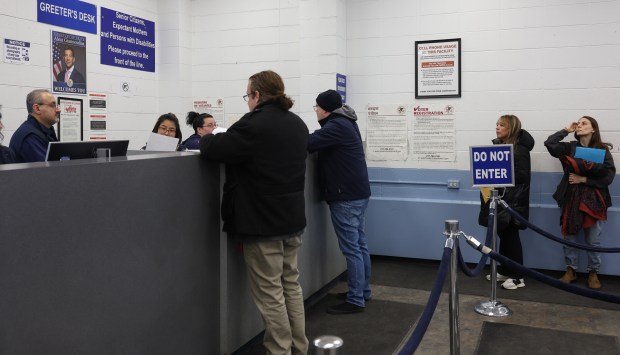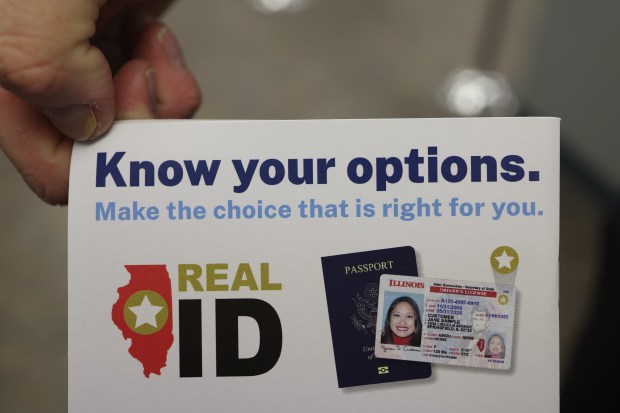SPRINGFIELD – Earlier this month, Austin Spa, a state Capitol security guard, felt pressured to get a Real ID card that he thought he would need to board a September flight. After almost two decades of extensions, it seemed a hard deadline was finally approaching and that after May 7, anyone without a passport would need a Real ID to board a plane.
But even with that deadline, it’s not clear he had to move so quickly.
Federal officials are not offering clear instructions on how the deadline for Real ID, which added a number of requirements for getting a state driver’s licenses or identification cards, will be enforced, and there are indications it may be phased in.
Given that, the Illinois secretary of state’s office is urging residents who don’t plan to fly anytime soon to hold off on applying for a Real ID. With over 9 million Illinois residents still without a Real ID and only 75 days until the deadline, the office fears an eleventh hour surge of people thinking they need the ID to drive or prove citizenship, neither of which is the case, could lead to even longer delays in processing applications.
“I don’t want to discourage anyone from getting a Real ID, but the fact is that not everyone needs a Real ID on May 7 and in some cases, might not ever need one,” Secretary of State Alexi Giannoulias said in an interview last week.
The Real ID Act, passed in 2005 as a security measure following a recommendation from the 9/11 Commission, aimed to set national standards for identification such as driver’s licenses. Under the initial plan, the ID would be required for boarding flights in the U.S and entering some federal facilities by 2008, but that deadline has been continuously extended amid opposition from states.
Under a January ruling by the U.S. Department of Homeland Security’s Transportation Security Administration, the May deadline isn’t really final.
The ruling allows federal agencies, including the Transportation Security Administration, to lead a phased REAL ID enforcement approach due to fears some states could be overwhelmed by the high number of residents still needing the document.
The Department of Homeland Security’s 2024 fiscal year budget appropriated about $23 million to support enforcement efforts.
As it stands, people without a Real ID or passport will still be allowed to board plans after May 7, with a warning from TSA. Giannoulias said TSA hasn’t been explicit with what a warning means and said that TSA “messaging has been all over the place.”
TSA’s Great Lakes regional spokesperson Jessica Mayle said the agency has not released the full enforcement plan because they want citizens to treat the deadline as final. The process of issuing warnings at airports for people without the IDs could also cause delays, Mayle said.
“If we have many hundreds or thousands of passengers without that, that could really stack up,” Mayle said. “I want people to keep in mind that the Real ID verifies your identity. If you don’t have a Real ID, or something to verify your identity in other ways, that could increase the delay to the passenger process.”
Mayle says TSA administration will clarify its enforcement plan closer to the May 7 deadline.
Giannoulias recommends Illinois residents make an appointment at a drivers services facility to apply for a Real ID, which costs $5 and requires the following documents:
— Proof of U.S. citizenship, lawful status, date of birth and identity, which can include a birth certificate, a valid passport, an employment authorization form, among other documents.
— A Social Security card or employment tax forms with a printed Social Security number.
— Proof of Illinois residency through documents that can include bank statements, canceled checks, school transcripts and utility bills.
— A written signature on an Illinois drivers license, among other signed documents.

Bob Dounis walked into a driver’s service facility on Chicago’s North Side to get his Real ID only to find appointments were necessary. But he said he was able to make one online 40 minutes later. The process went smoothly, and employees told him getting people to bring their Social Security card and birth certificate was 90% of the battle, he said.
Dounis doesn’t have a passport and flies domestically every two weeks for work.
“A passport is expensive, and there’s a waiting period,” said Dounis. “I’m not planning on doing any international flights so I don’t need a passport. Everything is domestic.”
But for others, the process has been frustrating. State Rep. Barbara Hernandez said she had to “stalk” the DMV for months to get an appointment and her documents were denied at first.
“I don’t think people are ready for (the deadline), and I don’t think they understand there’s a lot of requirements, a lot of paperwork that they need to obtain,” Hernandez said. “They shouldn’t wait until the last minute for sure.”
Hernandez recommends Illinois residents check for availability at 6:30 a.m. daily, when new appointments are added.
After a Real ID application is submitted, residents will receive a temporary paper driver’s license or state ID, but Mayle says paper IDs will not be accepted at airports.
Mayle said the May deadline is long overdue.
“There are so many layers of security there that are working the way they’re supposed to in the present day right now,” Mayle said “But I think having that consistent set of national standards has been a goal for a long time, and I think everyone will benefit once we’re on the other side of it.”
Robert Pape, professor of political science at the University of Chicago and director of the Chicago Project on Security and Threats, said the 9/11 attacks put a higher priority on identification for national security purposes
“Institutions were built in order to allow more direct and seamless sharing of intelligence information to prevent the cracks that we saw at 9/11 where 19 terrorists were able to legally get through the immigration system with really no problem whatsoever,” said Pape. “That was really startling.”
The Real ID program aimed to streamline identification card systems and close security loopholes. For example, Pape says in 1990s Arizona it was possible to get a driver’s license without showing evidence of citizenship.
“Then that tightened up, but there’s still some possibility there are people going back these many years that are still not completely caught up in the system,” said Pape.
Despite the purported benefits, states have been reluctant to adopt the Real ID.
Montana and Maine viewed the law as an intrusion on states’ rights and passed laws opposing Real ID. In Illinois, Democrats in power in Springfield resisted a national security mandate handed down by the Republican administration of George W. Bush, passing a joint resolution in 2007 urging the Illinois congressional delegation to repeal the Real ID act.
When the Real ID policy was proposed, the American Civil Liberties Union had a number of privacy concerns including fears that a national system could open a back door to Illinois driver data, according to ACLU of Illinois spokesman Edwin Yohnka.
Those concerns today almost seem quaint, he said.
“I think when we think of what’s happening with our data through our phones, or through AI, or through a host of other things, the Real ID is not the priority that it once was,” Yohnka said.
And in the decades of compliance delays, the Real ID program itself has changed.
Pape said the program became swept up in new politics on immigration, expanding beyond what it initially set out to accomplish and giving it more momentum.
“The issues generated 20 years ago have been superseded by these more current political issues, which are pretty vibrant,” Pape said. “You hear President (Donald) Trump, you hear his supporters talking about these issues all the time. These issues are hotly contested.”
Fred Tsao, policy director for Illinois Coalition for Immigrant and Refugee rights, said there are concerns that immigrants without Real IDs will automatically be assumed to be in the country without legal permisson.
“The assumption was that if you didn’t have a Real ID, you were undocumented, which is a very false assumption,” said Tsao. “So we want to try to dispel any such notion. It’s just wrong.”
Some officials are concerned Trump’s executive order on gender, recognizing two sexes, could affect Real IDs. Secretary of State Marco Rubio said the State Department would no longer issue “X” markers for passports for those who identify as neither male or female.
IIllinois added a gender-neutral option to drivers licenses in April 2024, and Deputy Secretary of State Scott Burnham said that will apply to Real IDs.
“The Real ID Act gives states the authority to determine the gender designation issued on driver’s license and ID cards, enabling Illinoisans to have their gender identity legally recognized on official Illinois documents,” Burnham said.




